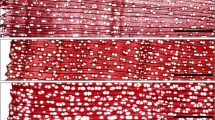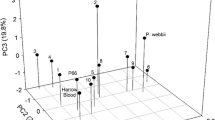Abstract
The localizing of pathogen (Ceratocystis ulmi) establishment in Dutch elm disease-resistant hosts is hypothesized as the major mechanism of resistance to this disease. Four factors are proposed that, singly or in all possible combinations, could regulate this general mechanism. We tested one of these factors, vessel size and number of contiguous vessels in the functional xylem at the point of natural inoculation. Using 23 selections from the Ulmaceae, we examined a constant area of second-year xylem of 2-year-old twigs. These anatomical data indicate that a correlation exists between increasing disease susceptibility and increasing vessel group size (the product of average vessel diameter and average number of contiguous vessels). Other evidence suggests that lateral pathogen movement is at first confined to the vessel group or groups of initial inoculation. Therefore, in a given limited time period, tylosis production could more effectively block vertical pathogen movement in vessel groups of small size. Relationships between vessel group size and the extent of sapwood discoloration are discussed. Vessel size and arrangement also is discussed in relationship to the resistance reported for young, greenhouse-grown trees. The use of vessel group size is suggested in screening programs for disease resistance. Recent research on oak suggests chemical modification of xylem tissue to lessen elm susceptibility.
Samenvatting
Als hypothese wordt gesteld, dat resistentie tegen de iepeziekte in de eerste plaats berust op het vermogen van resistente gastheren om de uitbreiding van de ziekteverwekker (Ceratocystis ulmi) te beperken. Er worden vier factoren genoemd die (alleen of in combinatie) dit vermogen zouden bepalen. Een van de vier werd getoetst, en wel afmeting van vaten en aantal aaneengrenzende vaten in de buitenste jaarring op de plaats waar natuurlijke infecties plaatsvinden. Er werden 22 iepeselecties en één andere Ulmacee gebruikt, waarin de vaten gemeten en geteld werden in een constant oppervlak van de dwarsdoorsnee van het tweede-jaars-hout van twee jaar oude twijgen. Deze anatomische gegevens tonen een correlatie tussen toenemende vatbaarheid voor de ziekte en toenemende vaatgroepgrootte, die hier gedefinieerd is als het produkt van de gemiddelde vatdiameter en het gemiddelde aantal aaneengrenzende vaten (zie Tabel 4). Uitbreiding van de schimmel in dwarsrichting van de boom is om te beginnen beperkt tot die vaatgroepen die oorspronkelijk geïnfecteerd waren. Daarom zal de uitbreiding van de schimmel in de lengterichting met meer effekt door thyllen geblokkeerd kunnen worden in vaatgroepen van geringere grootte.
De verhouding tussen vaatgroepgrootte en mate van houtverkleuring na infectie wordt besproken. Grootte en rangschikking van vaten wordt ook genoemd in verband met een zekere mate van resistentie van jonge, in de kas opgekweekte bomen. Het gebruik van vaatgroepgrootte wordt voorgesteld als een maatstaf bij het selecteren van resistente individuen uit grote populaties. Recent onderzoek over het effect van de stof TCPA op de anatomie van eiken suggereert dat het mogelijk is met chemicaliën de opbouw van het houtweefsel van iep te wijzigen en zodoende zijn vatbaarheid voor de iepeziekte te verkleinen.
Similar content being viewed by others
References
Banfield, W. M., 1938. The relation of sap flow, vessel length and spore distribution to development of Dutch elm disease in American elm. Phytopathology 28:3.
Banfield, W. M., 1941. Distribution by the sapstream of spores of three fungi that induce vascular wilt diseases of elm. J. Agric. Res. 62:637–681.
Banfield, W. M., 1947. Dutch elm disease recurrence in American elm in relation to the extent of vascular invasion by Ceratostomella ulmi in the year of disease incidence, Phytopathology 37:1.
Banfield, W. M., 1948. Time and locus of infection of American elms in relation to extent of vascular invasion by Ceratostomella ulmi. Phytopathology 38:2.
Banfield, W. M., 1968. Dutch elm disease recurrence and recovery in American elm. Phytopath. Z. 62:21–60.
Beckman C. H., 1966. Cell irritability and localization of vascular infection in plants. Phytopathology 56:821–824.
Brown, M. F., Campana, R. J. & Rosinski M. A., 1963. Downward movement of conidia of Ceratocystis ulmi from terminal twigs of elm. Phytopathology 53:871.
Buisman, Chr. J., 1936. Verslag van de onderzoekingen over de Iepenziekte, verricht in het Phytopathologisch Laboratorium “Willie Commelin Scholten” te Baarn gedurende 1935. Tijdschr. PlZiekt. 42:21–44 (Phytopath. Transl. 30:1–38).
Campana, R. J., 1967. Spore movement and limited symptom development of Dutch elm disease in small elm stems. Proc. Midwest. Chapter, Internat. Shade Tree Conf. 22:47–52.
Campana, R. J. & Hyland, F., 1970. Relation of foliar development to maturation of elm vessels and susceptibility to Dutch elm disease. Proc. Internat. Symposium on Dutch Elm Disease 1968. Iowa State University Press, Ames, Iowa (In press).
Caroselli, N. E. & Feldman, A. W., 1951. Dutch elm disease in young elm seedlings. Phytopathology 41:46–51.
Dimond, A. E., Plumb, G. H., Stoddard, E. M. & Horsfall, J. G., 1949. An evaluation of chemotherapy and vector control by insecticides for combating Dutch elm disease. Bull. Conn. agric. Exp. Stn., 531:1–69.
Elgersma, D. M., 1967. Factors determining resistance of elms to Ceratocystis ulmi. Phytopathology 57:641–642.
Elgersma, D. M., 1970a. Transport and multiplication of spores of Ceratocystis ulmi (Buisman) C. Moreau in susceptible and resistant elms. Proc. Internat. Symposium on Dutch Elm Disease 1968. Iowa State University Press, Ames, Iowa (In press).
Elgersma, D. M., 1970b. Length and diameter of xylem vessels as factors in resistance of elms to Ceratocystis ulmi. Neth. J. Pl. Path. 76:179–182.
Greenidge, K. N. H., 1952. An approach to the study of vessel length in hardwood species. Am. J. Bot. 39:570–574.
Hart, J. H., 1960. Water relations and colonization in elm by Ceratocystic ulmi. Unpublished. M. S. thesis, Iowa State University Library, Ames, Iowa.
Heybroek, H. M., 1957. Elm-breeding in The Netherlands. Silvae Genet. 6:112–117.
Holmes, F. W. & Demaradzki, J. S., 1960. Hemiptelea and the Dutch elm disease. Rep. Mass. agric. Exp. Stn. 1959–1960, Bull. 524:34.
Kerling, L. C. P., 1955. Reactions of elm wood to attacks of Ophiostoma ulmi (Buism.) Nannf. Acta bot. neerl. 4:398–403.
MacDonald, W. L. & McNabb Jr, H. S., 1970. Fine-structural observations of the growth of Ceratocystis ulmi in elm xylem tissue. BioScience (In press).
May, C., 1935. The Dutch elm disease from the research standpoint. Proc. Natn. Shade Tree Conf. 11:122–127.
Neely, D., 1968. Twig inoculations on American elm with Ceratocystis ulmi. Phytopathology 58:1566–1570.
Ouellette, G. B., 1962. Studies on the infection process of Ceratostomella ulmi (Buism.) C. Moreau in American elm trees. Can. J. Bot. 40:1567–1575.
Pomerleau, R., 1965. The period of susceptibility of Ulmus americana to Ceratocystis ulmi under conditions prevailing in Quebec. Can. J. Bot. 43:787–792.
Pomerleau, R., 1966. Relation of early cambial activity in white elm and infection by Ceratocystis ulmi (Buism.) C. Moreau. Can. J. Bot. 44:109–111.
Pomerleau, R. & Mehran, A. R., 1966. Distribution of spores of Ceratocystis ulmi labelled with phosphorus-32 in green shoots and leaves of Ulmus americana. Naturaliste Can. 93:577–582.
Pope, S. A., 1943. Some studies on the Dutch elm disease and the causal organism. Unpublished Thesis, Cornell University Library, Ithaca, New York.
Priestley, J. H., Scott, L. I. & Malin, M., 1935. Vessel development in the angiosperms. Proc. Leeds phil. lit. Soc. 3:42–53.
Sass, John E., 1958. Botanical microtechnique. 3rd ed., Iowa State University Press, Ames, Iowa.
Tchernoff, V., 1965. Methods for screening and for the rapid selection of elms for resistance to Dutch elm disease. Acta bot. Neerl. 14:409–452.
Venn, K. O., Nair, V. M. G. & Kuntz, J. E.,1968. Effects of TCPA on oak sapwood formation and the incidence and development of oak wilt. Phytopathology 58:1071.
Went, J. C., 1954. The Dutch elm disease-summary of fifteen years hybridization and selection work (1937–1952). Tijdschr. PlZiekt. 60:109–127.
Wilson, C. L., 1965. Ceratocystis ulmi in elm wood. Phytopathology 55:477.
Author information
Authors and Affiliations
Additional information
Journal Paper No. J-6392 of the Iowa Agricultural and Home Economics Experiment Station, Ames, Iowa. Project No. 1706. Appears also as Mededeling 106 of the Forest Research Station “De Dorschkamp”.
Rights and permissions
About this article
Cite this article
McNabb, H.S., Heybroek, H.M. & Macdonald, W.L. Anatomical factors in resistance to Dutch elm disease. Netherlands Journal of Plant Pathology 76, 196–205 (1970). https://doi.org/10.1007/BF01974331
Accepted:
Issue Date:
DOI: https://doi.org/10.1007/BF01974331




